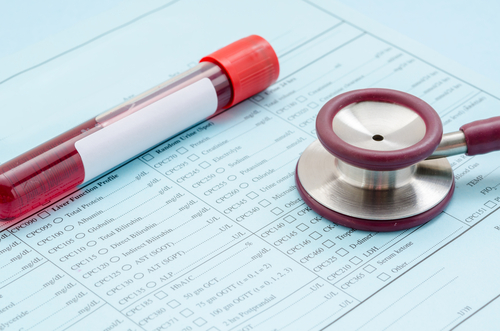#ECTRIMS2019 – Real-world Data Supports Serum Neurofilament Light as Potential MS Biomarker

Serum neurofilament light chain (sNfL) in the blood — a proposed biomarker for multiple sclerosis (MS) — is linked with worse neurologic function at levels above a certain threshold, according to data from a large, real-world study.
Kathryn Fitzgerald, assistant professor at the Johns Hopkins School of Medicine, presented the data today on the first day of the 35th Congress of the European Committee for Treatment and Research in Multiple Sclerosis (ECTRIMS). The ECTRIMS conference is being held Sept. 11-13, in Stockholm, Sweden.
The presentation, titled “Serum neurofilament light chain is associated with MS outcomes and comorbidity in a large population of people with multiple sclerosis,” was part of the Young Scientific Investigators’ Session 1 on biomarkers.
Neurofilaments are nerve cell-specific components that can be measured in different body compartments, including the blood, where its accumulation is a sign of neuron degeneration and damage. Levels of sNfL above a certain threshold have been proposed as a potential biomarker for MS.
“NfL is a marker of neuronal injury,” Fitzgerald said, adding that its levels are “elevated in many neurological disorders.”
“In MS, serum NfL is emerging as a strong candidate biomarker that correlates with disease severity,” showing “potential to be used for disease monitoring and risk stratification,” she added.
However, to be used as a predictive marker, further research is needed, testing sNfL’s diagnostic potential in large, heterogeneous MS populations with diverse demographics and comorbidities. Comorbidity refers to the simultaneous presence of two chronic diseases or conditions in a patient.
Researchers at the Johns Hopkins School of Medicine quantified the levels of sNfL in blood samples from 1,969 people with MS enrolled in the MS Partners Advancing Technology and Health Solutions (MS PATHS) program. A large network of 10 healthcare institutions in the U.S. and Europe, MS PATHS has a “standardized collection of patient information (including demographic, lifestyle, clinical, radiographic), and biosamples,” Fitzgerald said.
As controls, blood samples from 135 healthy individuals were analyzed.
The mean age of the group of MS patients was 47.7 years, and the majority of participants were women (73.5%). Five comorbidities were most common: 36% of the group’s members had reduced kidney function, 35% had obesity, 28.4% had hypertension, 16.9% had hyperlipidemia (high fat content in blood), and 6.1% had diabetes.
The levels of sNfL were quantified using Quanterix’s Simoa Technology, an ultra-sensitive technology for biomarker detection. Individuals were categorized as having high or normal levels of sNfL, and were compared for comorbidities, walking speed, manual dexterity, and cognitive speed, as well as MS duration, gender, and treatment.
Since sNfL levels increase with age, that factor was taken into account when setting up cut-off values for high and normal sNfL levels.
The analysis revealed that 25% of the MS patients analyzed had high levels of sNfL — and these individuals had greater disability.
Compared with patients with normal sNfL levels, the walking speed of those with high sNfL levels was lower (10.01% slower). Manual dexterity speed, or the ability to control and make coordinated hand and finger movements, was 7.24% slower. The cognitive (processing) speed scores of MS patients with high levels of sNfL also was lower, by 8.23%, compared with those with normal levels.
Among other comorbidities, diabetic MS patients were significantly more likely to have high levels of sNfL, the data showed. Fitzgerald said the link between obesity and sNfL levels was found to be “complex and may vary by disability” level.
The researchers saw no influence of race, or metabolic parameters, namely hyperlipidemia, in the levels of sNfL. sNfL levels also did not differ according to the presence of hypertension or renal insufficiency in patients.
Overall, the data showed that “elevated sNfL was associated with poorer neurologic function, including slower walking speed and manual dexterity, poorer cognitive performance, and increased self-reported disability,” Fitzgerald said.
The researcher also emphasized that “elevated sNfL was associated with diabetes,” but not with other comorbidities analyzed, specifically hypertension, hyperlipidemia, or renal dysfunction.
The data “support the existing evidence that serum NfL is a promising candidate marker for disease burden in people with MS,” Fitzgerald concluded.
Further research is required to assess whether comorbidities affect the link between sNfL levels and MS outcomes in the long-run, the researchers said.






